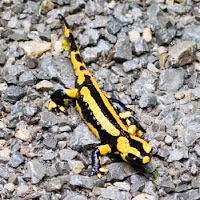Vertebrates
Animals possessing a vertebral column are vertebrates.These are of 5 types.
Some common features in vertebrates:
Presence of vertebral column
Bilateral symmetry
Triploblastic body
Presence of internal skeleton
Comprises 2 pairs of fins/limbs
Well developed central nervous system, including brain
The 5 types of vertebrates are :
Pisces (Fish)
Amphibia (Amphibians)
Reptilia (Reptiles)
Aves (Birds)
Mammalia (Mammals)
Pisces (Fish)
 |
| Fish |
Fish
are ectothermic (cold-blooded/poikilothermic), so their body
temperature fluctuates with the environment.Their skin is generally
covered with scales.The limbs in fish are modified into fins, and their
bodies are streamlined which helps them move easily through
water.Respiration takes place through gills, and a 2-chambered
heart.Fish have no eyelids or external ears.They lay eggs in water.
According to the composition of bones, fish are of 2 types :
- Cartilaginous Fish - Skeleton is composed of cartilage.Eggs are internally fertilized.Tooth-like scales are present. Examples : Shark, Skates
 |
| Skate |
 |
| Shark |
- Bony Fish - Skeleton
is composed of calcarious bones (mainly of Calcium). Eggs are
externally fertilized.Cycloid (Smooth) scales are present. Examples:
Seer, Tuna
 |
| Seer |
 |
| Tuna |
Amphibia (Amphibians)
Amphibians live on water as well as on land.All amphibians start their lives in water with gills and tails.As they grow, they develop lungs and legs for their life on land.They have 4 limbs for locomotion.Their skin is moist with the presence of glands, and no scales, hairs or feathers are present on the skin.Gaseous exchange takes place via lugs, moist skin & buccal cavity.Amphibians have a three-chambered heart and are
cold-blooded.
 |
| Salamander |
 |
| Frog |
Reptilia (Reptiles)
This is the first group of animals which have truly adapted to live in the terrestrial environment.Reptiles are cold-blooded animals with dry, scaly skin without glands. They bear their young in eggs covered with a leathery shell.All reptiles have a 3-chambered heart, except in the crocodile, which has a 4-chambered heart.Some of these posses legs, while the others don't, and the ones that do, contain claws at the tip of the fingers.
 |
| Snake |
 |
| Tortoise |
 |
| Lizard |
Aves (Birds)
Birds are vertebrates with feathers modified for flight & active metabolism.They are warm blooded or homeothermic.Consists of a 4-chambered heart and a streamlined body which helps in flight.The forelimbs are modified as wings for flight, and the hind limbs for walking. Has a beak, but no teeth.Bones are usually light-weight & hollow.Gaseous exchange takes place via lungs.Lays eggs comprising a hard shell.Has a well-developed cerebrum.
 |
| Aves |
 |
| Aves |
Mammalia (Mammals)
Mammals are the most evolutionary & advanced group of animals.This group is relatively small, with approximately 4500 species.The skin is covered with hair, & bears 2 types of glands : Sebaceous glands & Sweat glands. They give birth to young while the fetus grows inside the womb.Young ones feed on breast milk secreated by the mammary glands.They have heterodont dentition (different types of teeth). They also have external ear lobes, movable eyelids, 4-chambered heart, and are warm-blooded. Though the platypus & anteater lay eggs, and the bat can fly, they are all mammals.
 |
| Mammals |
 |
| Humans |
 |
| Bat |
 |
| Anteater |
 |
Platypus
|

















No comments:
Post a Comment